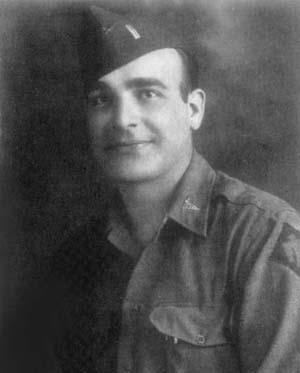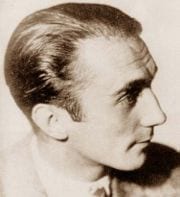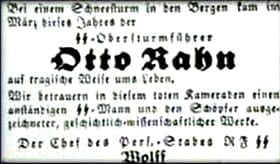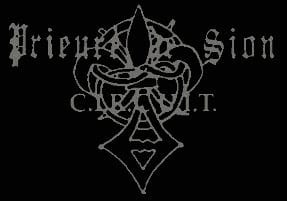Otto Rahn: To Rennes or not to Rennes?

Claims
“The Emerald Cup-Ark of Gold: the Quest of SS Lt Otto Rahn of the Third Reich”, Colonel Howard Buechner claimed that Otto Rahn visited the Corbières in 1937. This visit is not substantiated. However, there is little doubt in my mind that there is a strong connection between Rahn and Rennes-le-Château. I found these connecting links:
- Rahn’s link to the Cathars whom he loved with great passion;
- The war waged against the Cathars by the Church and the French King, a war of such ferocity that it brings into question the true nature of the cause for which the crusade against Albigensian and Cathar was really launched;
- Rennes-le-Château is seated in the Cathar heartland; Saunière discovering something linked to the “real” story of Catholic geopolitical involvement in the West over the centuries;
- The Vatican not speaking out against the Nazis until close to the end of WWII. What was the Church afraid of?
- Jules Massenet and his librettist Henri Cain for the opera: Don Quichotte and the metaphysical concepts of the necklace image and of the Island of Dreams;
- The various legends of the seven sleepers—Mary Magdalene and the Sleepers of Ephesus, Otto Rahn’s account of the legend Roses of Bozen, even the story of Snow White;
- Nacht und Nebel/Société Angelique (Le Brouillard) ;
And finally a long shot:
- Feodor Chaliapin, the renowned Russian baritone, and his links with Pius X and with Bérenger Saunière.
From Cathars
How do we link Rahn and his brief life to Rennes-le-Château? We must remember first and foremost that Saunière was a Catholic priest. What was it that Rahn loved with all his heart but that the Church hated with such vitriol? The Cathars. The Cathar movement was crushed by the Catholic Church and the King of France with extreme brutality.
One hundred and fifty years after these Crusades came the witch-hunts during when an estimated six to nine million people, eighty five percent of them women, were executed. The only crime of the Cathars was to believe in another way. At the heart of all major religions there is a pearl of great beauty. Its light cannot take sides. By definition, those from within the Church who allow these acts are at the same time outside the true church. Aggression on such a scale has to have another motive. And was this motive what Rahn was seeking?
To Nazis
 What prevented the Church deploring the Nazis atrocities when they became evident early on in the war rather than waiting until the very end to speak up, and then only half-heartedly? Some say it was the secret Kirchensteur funds Hitler paid the Church during that time, but was it just that?
What prevented the Church deploring the Nazis atrocities when they became evident early on in the war rather than waiting until the very end to speak up, and then only half-heartedly? Some say it was the secret Kirchensteur funds Hitler paid the Church during that time, but was it just that?
What did the Nazis hold over the Church to keep it quiet so all those Catholic soldiers did as they were told? Otto Rahn was privy to the inner secrets of the Nazi elite. It is a safe bet he would have known something of the pressures the Nazis exerted over Pius XII to deter him from voicing public criticism of Hitler’s policies and actions. Monsignor Mayol de Lupe, Chaplain of the French S.S. Brigade Charlemagne, was a personal friend of Pius.
The Catholic Centre Party emerged from the Great War as a major force in Germany after forty years of suppression instigated by Bismarck. Its renewal allowed the Party to gain rapidly in influence and it succeeded in forcing a repeal of the anti-Jesuit laws passed in 1872. From that time the Society of Jesus was free to enter Germany and to found colleges, schools and communities. It engaged in these activities with great vigour. It is perhaps of little wonder that Otto Rahn was deeply distrustful of the Jesuits in Germany (and they of him) considering the subject, tone and passion of his pro-Cathar/anti-(Catholic) Church writings.
And the Jews
The Reich Concordat, signed on 20th July 1933, legally (but certainly not spiritually or ethically) bound the Catholic Church in Germany to silence on outrages against the Jews because by that time the persecution and elimination of Jews in Germany was stated policy. Also in place by that date was the adoption of the Law for Prevention of Genetically Diseased Offspring, which called for sterilisation of all those suffering from hereditary mental or cognitive diseases, including blindness and deafness. Consequent to the passing of this law, nearly three hundred and fifty thousand people would ultimately be sterilised in the Third Reich, most without family permission.
In strict legal terms the Concordat bound the Church’s hands from speaking out against such atrocities, or at least it was a major excuse trotted out to try to appease those who railed against the Church’s pusillanimity. The guiding hand behind the drafting of the Concordat and the lengthy process of agreeing it with Hitler was Eugenio Pacelli who in 1933 was Vatican Secretary of State and who assumed the pontificate a short time later.
The Church holds the key
 Through time everyone keeps looking for a treasure and ignores the Church but I am convinced that it is within the Church that we will (eventually) find the key to the Rennes-le-Château mystery, which leads us to the influence of the Habsburgs in the inner sanctums of the Church. The Habsburgs still controlled who would become the Pope through the Curia. Franz Joseph exercised his veto as head of the Austrian-Hungary Empire against Leo XIII’s candidate for the papacy, Cardinal Rampolla.
Through time everyone keeps looking for a treasure and ignores the Church but I am convinced that it is within the Church that we will (eventually) find the key to the Rennes-le-Château mystery, which leads us to the influence of the Habsburgs in the inner sanctums of the Church. The Habsburgs still controlled who would become the Pope through the Curia. Franz Joseph exercised his veto as head of the Austrian-Hungary Empire against Leo XIII’s candidate for the papacy, Cardinal Rampolla.
Nazism was a religion with Adolf Hitler as its object of veneration. Many of its principles were Catholic, including Hitler and Himmler. Practically every right-wing dictator in the 1930s and 1940s was brought up as a Catholic: Hitler, Franco, Petain, Mussolini, Tiso and Pavelic (whose lust for sadistic and bloody mass murder in Croatia was arguably even more rabid than that of Hitler).
Hitler saw himself as the Anti-Pope, referring to Himmler as “my Ignatius.” In boyhood, Hitler attended the school at Lambach where he sang in the choir. There the young Adolf became acquainted with the symbol of the swastika because it was the heraldic design of Father Hagen, the abbey’s administrator.
An insider’s story
For a brief period Otto Rahn was an inside member of this “Nazi” church, which further enhances the perception of history that major first-level actions (wars, crusades, pogroms) are, more often than not, shrouds that conceal deeper levels of action on behalf of dark and unidentifiable secret interest groups, invariably male dominated, and equally invariably, at the expense of the personal freedoms of humankind. In the early summer of 1914 it was evident to observers that events in Europe were building to a catastrophic conclusion.
After the death of a very elderly former Monsignor in the 1980s, his diary was found to contain an extraordinary account. The entry recounted how as a young priest, gifted in languages, he was despatched by Pius X to Vienna in July 1914 to meet with Emperor Franz Joseph. The papal emissary’s mission was to beg Franz Joseph to use his enormous influence to avert conflict. He was ushered into the presence of the living legend, the Habsburg monarch who had been the crowned head of Europe for over forty years. The Emperor humbly welcomed him and then sank to his knees in tears, distraught that he had not been able to use his power and influence to save the lives of his family who had met with recent violent death. Franz Joseph asked him if he would hear his confession. The young man fell into the old devil’s trap. During the confession the Emperor revealed that in the coming days he would declare war on Serbia, an act he knew would gather apace and ignite the Great War. Franz Joseph finished his confession, rose, and laughed at the young emissary, saying: “priest, you have heard my confession and, therefore, you have assumed my guilt. I shall put the world to the sword free from sin...”

War
Perhaps in this anecdotal account we have a reason why the Nazis had a stick with which to beat the Vatican during World War II. Merry del Val was soon pressing Prince Schonberg, the Austrian ambassador to the Holy See, to encourage Austria to react vigorously to the events in Serbia. Del Val signed the concordat a few days before the assassination that started the war.
So what is the prize that the Church and the Anti-Church (are they interchangeable?) were prepared to kill for in such huge numbers? What were the real objectives of Himmler’s worldwide Ahnenerbe initiatives?
I believe we have to focus on the concept of the Grail. If the quest was for something tangible then the thing would have been found long before 1945, considering all the massive resources, manpower and money that have been thrown at it over the centuries. The heat would have dissipated. But if the pearl was less material and more ‘Taoistic’ in nature (that which is, isn’t), then slaughtering in ever vaster numbers only makes sense if these actions were mounted to conceal the nature of the real conflict—the eternal battle for the souls of humankind.
Lucifer’s Court
The Court of Lucifer is an expedition through the “garden of roses,” Rahn’s affectionate term for the Middle Earth Kingdom of the Asgardian Elfin, Lorin, and a realm closed to non-believers or the uninitiated. Rahn dreams of a return to Thule, the primordial centre of the European Hyperboreans. He pines for a return to the Golden Age. Rahn’s account of the Elfin legend is filled with powerful themes and images that might provide a clue to the real mystery, among them: the Knight of the lineage of Dietrich, the Troj de Reses, a shepherdess, an enchanted windmill, the seven dwarfs, the fiancé of the Month of May, and a web of woven silk.
Taken together, these elements describe a story of initiation by one pursuing a Quest under the protection of ancient guardians, while developing a clue-key to the Higher Self to unlock an unseen door and enter the worlds within. The ability to gain access to these magical realms is denied to those who are not pure of heart. The Church’s appalling record of oppressive and, frankly, murderous behaviour towards millions of men and women during the last two millennia has demonstrated wholesale spiritual vacuity within its ranks, top down. Consequently, the accumulated blood spilt in the torture chambers and bonfires of the Inquisition has concealed from the Church the pathway to Laurin for all time, despite its ceaseless efforts to arrogate the power of the Grail.
The skeleton key
 Image: Newspaper report announcing Rahn's death
Image: Newspaper report announcing Rahn's death
The word dietrich in German means skeleton key. Time and again in his writings Ottto Rahn said he possessed the dietrich, a key to something imperceptible to the physical senses. The French equivalent is passe-partout, which “happens” to be the name of Phileas Fogg’s companion in Around the World in Eighty Days, providing us with a link to the ubiquitous Jules Verne and the allusions in his work to the Rennes area, Bugarach being an example.
The Cathars and the Templars are reputed to have been the Guardians of the Grail. Rahn wrote (quoted from Croisade contre le Graal, the French edition of Rahn’s first book Kreuzzug gegen den Gral): “quand tombe la nuit méridionale, des étoiles d’une invraisemblable grandeur scintellent et rayonnent, si proches qu’on imagine presque pouvoir les atteindre de la main.” To touch the stars is to fasten the necklace upon the Goddess. The Quest for the Grail is a quest to find the Goddess within because it is she who stands at the threshold to all other worlds of mystery and enchantment. Artists and key historical figures have long sought to illustrate the timeless and poetic nature of this most personal and special of adventures, and it is they that provide us with some of the less obvious links between Rahn and Rennes-le-Château.
The Priory and initiation
 A principle contributor to the Priory of Sion hoax, Philippe de Chérisey, claimed that Paul Éluard’s poem – La terre est bleue comme une orange – was a veiled reference to the mysterious “blue apples” component in the Saunière parchments. De Chérisey expanded on his theory, saying that Éluard’s conflation of bleu, ange, l’or (phonetically Blue Angel) finds expression both in the 1930s Marlene Dietrich film Blue Angel (which alludes to a discovery that refers to Mary Magdalene - Madeleine the Sinner) and in the window of the Chapel of the Angels in Saint Sulpice, a chapel linked with the Société Angelique.
A principle contributor to the Priory of Sion hoax, Philippe de Chérisey, claimed that Paul Éluard’s poem – La terre est bleue comme une orange – was a veiled reference to the mysterious “blue apples” component in the Saunière parchments. De Chérisey expanded on his theory, saying that Éluard’s conflation of bleu, ange, l’or (phonetically Blue Angel) finds expression both in the 1930s Marlene Dietrich film Blue Angel (which alludes to a discovery that refers to Mary Magdalene - Madeleine the Sinner) and in the window of the Chapel of the Angels in Saint Sulpice, a chapel linked with the Société Angelique.
It also alludes to the mystery of the raising of Lazarus (recorded as having taken place on January 17). Many believe that the Biblical Lazarus episode is an allusion to the practice among Ancient Wisdoms of an initiation ceremony in which the neophyte enters a deep near-death trance state for three days while their spirit-soul travels in the inner worlds to receive teachings from sages and masters. Rahn’s depiction of the adventures of the sleeping millers and the Knight of Berne’s search for the fabled Kingdom of Laurin is a close parallel. Incidentally, together with singer Josephine Baker, Marlene Dietrich is said to have been Otto Rahn’s houseguest in 1932 during his ill-fated spell as a hotel proprietor in the Hôtel-Restaurant des Marronniers in Ussat-les-Bains.
Another singer and a mystery
The Catholic Church is the hub for these connecting spokes. Who were the personalities on the field of play? The Pope in office at the time Saunière made his discoveries was Leo XIII, who was succeeded in 1903 by Pius X. Pius was an admirer of Feodor Chaliapin, the larger-than-life Russian baritone who is said to have sung privately for Pius at Castel Gandolfo in the months before the outbreak of World War I. In his biography Chaliapin makes a cryptic comment in the opening pages, referring to “that Bérenger volume, that precious Trio I had composed.” The words are too direct to be coincidental but what are we intended to infer from them? Jules Massenet composed Don Quichotte specifically for Chaliapin. Henri Cain’s libretto for the opera is full of striking allusions to “keys (dietrichs), vanishing doorways, Islands of Dreams, jewels and sacred causes.” These men were trying to tell us something.
The Secret
After Pius’ death a movement arose calling itself the Society of Saint Pius X, an extreme traditionalist group. It claimed to have a great secret, linked to the Third Fatima Prophecy, which is said to be connected to Rennes-le-Château. This secret, they claimed, would bring down the papacy.
The Vatican in Pius’ day was even said to have nuns serving the pontiff who were linked to an ultra-secret Parisian guild of Sacred Prostitutes located in the Rue d’Amboise, priestesses who provided an unbroken link to the original Temple of Ishtar and its feminine-based rites and initiations. Saunière went to great lengths to emphasize the Magdalene, both in the church at Rennes-le-Château and in his Villa Bethania.
Return to Rahn
Otto Rahn’s love for the Cathars, his involvement with the inner Church of Nazism which, in turn, had a stranglehold on the papacy, his narration of key fables and legends suggestive of worlds of enchantment attainable by those with a key, (which they all carry with or within them), and his alleged connection with Dagobert’s “forbidden merchandise” episode of 1945, all link him to Rennes-le-Château and its environs.
Before we accompany Otto Rahn out of the environs of Rennes-le-Château we should make brief mention of a purported yet tantalising link between Rahn and the Nazis’ search for the Arma Christi, the Instruments of the Passion used during the Crucifixion.
Rahn and the Arma Christi?
 In 2006 Dutch author Karl Hammer-Kaatee published his novel Satans Lied: De Jacht van de CIA op Jezus. Waargebeurd verhaal—”Satan’s Song: the CIA Hunt For Jesus. A true story.” The book, not yet available in an English language edition, relates the testimony of countryman “Tom R”, who worked in Munich for the Art Looting Investigation Unit (ALIU), the U.S. secret service body investigating German art thefts during World War II. During this work Tom R. learned about the theft of two panels of Jan van Eyck’s ‘Adoration of the Mystic Lamb’. One of the panels, the Just Judges, was said to contain the key to the geographical location of the Arma Christi. It had been missing since April 1934, six months after Otto Rahn had allegedly undertaken on Himmler’s behalf a mission in Ghent to make preparations for its theft. It would appear, though, that when the panel was stolen the following spring a different party of thieves was involved because it later became the subject of a three-year search by the Nazis. The story goes that Tom R, having been ordered by the CIA to find the holy instruments, got very close to actual discovery and went into hiding.
In 2006 Dutch author Karl Hammer-Kaatee published his novel Satans Lied: De Jacht van de CIA op Jezus. Waargebeurd verhaal—”Satan’s Song: the CIA Hunt For Jesus. A true story.” The book, not yet available in an English language edition, relates the testimony of countryman “Tom R”, who worked in Munich for the Art Looting Investigation Unit (ALIU), the U.S. secret service body investigating German art thefts during World War II. During this work Tom R. learned about the theft of two panels of Jan van Eyck’s ‘Adoration of the Mystic Lamb’. One of the panels, the Just Judges, was said to contain the key to the geographical location of the Arma Christi. It had been missing since April 1934, six months after Otto Rahn had allegedly undertaken on Himmler’s behalf a mission in Ghent to make preparations for its theft. It would appear, though, that when the panel was stolen the following spring a different party of thieves was involved because it later became the subject of a three-year search by the Nazis. The story goes that Tom R, having been ordered by the CIA to find the holy instruments, got very close to actual discovery and went into hiding.
In his book Hammer-Kaatee states that at one time the Arma Christi, guarded by a Franciscan network calling itself the Ebionites, were transported twenty kilometres south from their hiding place at Notre Dame de Marceille at Limoux to Rennes-le-Château, only to be taken back to Limoux when Rahn got too close for comfort. The Arma Christi story is fascinating but there is no proof of any involvement by Otto Rahn. At the same time there is no way at present one can prove or disprove that Rahn might have taken time away from promoting Kreuzzug gegen den Gral to travel to Ghent under Himmler’s orders in the autumn of 1933.
In postscript, the Franciscan element within the Arma Christi story introduces us to a fascinating piece of Indiana Jones mythography. Film cognoscenti claim that at one time Spielberg and Lucas wanted to make ‘Indiana Jones and the Vatican’ but were prevented from doing it. One can only speculate upon the circumstances but if there is any truth to the claim it would be fascinating to unearth the details of the story, and to understand why the pair was deterred from turning it into the episode of their choice.
Nigel Graddon<
Similar By Terms
|
(English)
|
(Deutsch)
|
(English)
|
(English)
|
|
(English)
|
(English)
|
(Español)
|
(English)
|








Recent comments
13 years 41 weeks ago
13 years 42 weeks ago
13 years 42 weeks ago
13 years 42 weeks ago
13 years 45 weeks ago
13 years 51 weeks ago